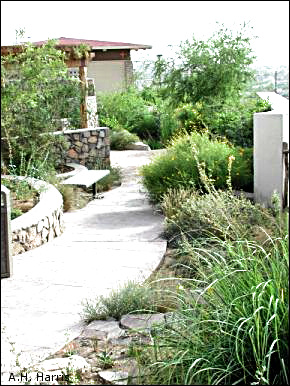
Much of the northern Chihuahuan Desert is populated with people from elsewhere—from lands with landscapes of green grass and places with forests growing even in the lowlands. Such is the mental image imported with the immigrants. A few years ago, in a local children's poster contest focused on living friendly with the earth, not a single poster featured the desert. Rather, those that showed a landscape were resplendent with green grass, cows grazing in lush pastures, and groves of apple trees.
Too many newcomers are told that they have two choices in their
landscaping. Either recreate their verdant homeland vegetation or go to rock and cactus
water-conserving barrenness. But there is hope yet. With increasing numbers of books on
Southwestern gardening aimed at serving both beauty and water conservation, and with
the Chihuahuan Desert Gardens on the UTEP campus as a model and showcase, true
native-plant gardens are spreading in our region. These desert-adapted plants replace
water-hungry lawns and stark gravel yards with colorful flowers and native
greenery—both a feast for the eye and a balm for a water-aware conscience.
![]()
Contributor: Arthur H. Harris, Laboratory for Environmental Biology, Centennial Museum, University of Texas at El Paso.
Desert Diary is a joint production of the Centennial Museum and KTEP National Public Radio at the University of Texas at El Paso.

Water friendly, but hardly barren stone and cactus. A portion of the Chihuahuan Desert Gardens on the University of Texas at El Paso campus. Photograph by A.H. Harris, 22 May 2002.